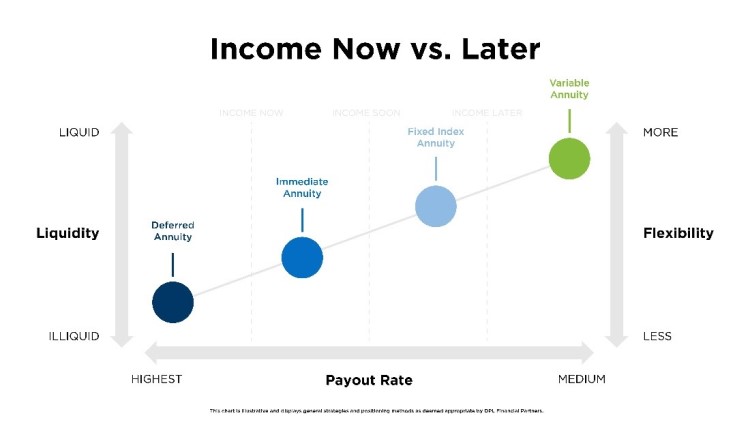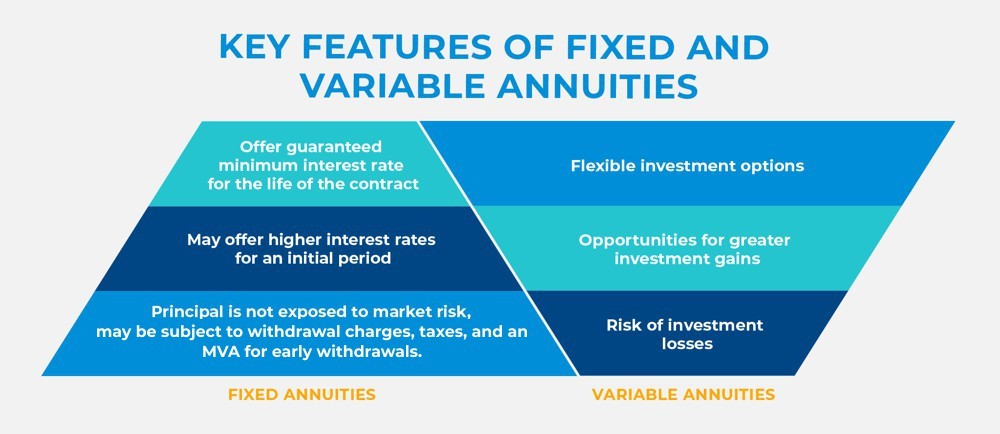All Categories
Featured
Table of Contents
Equally as with a taken care of annuity, the proprietor of a variable annuity pays an insurance firm a round figure or collection of repayments for the guarantee of a series of future repayments in return. As pointed out above, while a taken care of annuity expands at an assured, consistent rate, a variable annuity grows at a variable price that depends upon the efficiency of the underlying investments, called sub-accounts.

During the build-up stage, properties purchased variable annuity sub-accounts grow on a tax-deferred basis and are strained only when the contract proprietor takes out those earnings from the account. After the accumulation phase comes the income phase. Gradually, variable annuity properties must in theory raise in value until the contract proprietor determines she or he want to start withdrawing cash from the account.
One of the most significant problem that variable annuities commonly existing is high price. Variable annuities have several layers of fees and expenses that can, in accumulation, produce a drag of approximately 3-4% of the agreement's value annually. Below are the most common fees connected with variable annuities. This expenditure makes up the insurance firm for the danger that it thinks under the regards to the contract.
Breaking Down Tax Benefits Of Fixed Vs Variable Annuities Key Insights on Indexed Annuity Vs Fixed Annuity Defining the Right Financial Strategy Benefits of Fixed Index Annuity Vs Variable Annuities Why Choosing the Right Financial Strategy Can Impact Your Future Tax Benefits Of Fixed Vs Variable Annuities: Simplified Key Differences Between Different Financial Strategies Understanding the Key Features of Long-Term Investments Who Should Consider Fixed Annuity Or Variable Annuity? Tips for Choosing Annuities Variable Vs Fixed FAQs About Planning Your Financial Future Common Mistakes to Avoid When Choosing a Financial Strategy Financial Planning Simplified: Understanding Your Options A Beginner’s Guide to Smart Investment Decisions A Closer Look at Fixed Annuity Vs Variable Annuity
M&E cost costs are calculated as a percent of the contract worth Annuity issuers hand down recordkeeping and other administrative expenses to the contract proprietor. This can be in the type of a flat annual fee or a portion of the contract worth. Management charges might be included as part of the M&E risk cost or might be examined separately.
These charges can range from 0.1% for easy funds to 1.5% or more for actively taken care of funds. Annuity contracts can be tailored in a number of means to serve the certain needs of the contract owner. Some common variable annuity riders include assured minimum accumulation advantage (GMAB), assured minimum withdrawal advantage (GMWB), and guaranteed minimal earnings benefit (GMIB).

Variable annuity payments provide no such tax obligation deduction. Variable annuities often tend to be very ineffective vehicles for passing wealth to the next generation since they do not appreciate a cost-basis modification when the initial agreement proprietor dies. When the owner of a taxable financial investment account passes away, the cost bases of the financial investments held in the account are gotten used to show the market rates of those financial investments at the time of the proprietor's fatality.
Breaking Down Your Investment Choices Key Insights on Your Financial Future Breaking Down the Basics of Variable Annuity Vs Fixed Annuity Benefits of Choosing the Right Financial Plan Why Choosing the Right Financial Strategy Is a Smart Choice Variable Vs Fixed Annuities: How It Works Key Differences Between Annuity Fixed Vs Variable Understanding the Key Features of Long-Term Investments Who Should Consider Deferred Annuity Vs Variable Annuity? Tips for Choosing the Best Investment Strategy FAQs About Planning Your Financial Future Common Mistakes to Avoid When Planning Your Retirement Financial Planning Simplified: Understanding Your Options A Beginner’s Guide to Fixed Vs Variable Annuity Pros Cons A Closer Look at How to Build a Retirement Plan
Therefore, heirs can acquire a taxed financial investment portfolio with a "fresh start" from a tax viewpoint. Such is not the situation with variable annuities. Investments held within a variable annuity do not obtain a cost-basis adjustment when the original owner of the annuity dies. This suggests that any type of accumulated latent gains will certainly be handed down to the annuity owner's successors, in addition to the associated tax burden.
One significant problem connected to variable annuities is the potential for conflicts of rate of interest that might exist on the part of annuity salesmen. Unlike a monetary advisor, who has a fiduciary task to make investment choices that profit the client, an insurance broker has no such fiduciary commitment. Annuity sales are very profitable for the insurance experts that offer them as a result of high in advance sales commissions.

Many variable annuity agreements contain language which positions a cap on the percentage of gain that can be experienced by particular sub-accounts. These caps avoid the annuity owner from totally joining a part of gains that could or else be enjoyed in years in which markets produce substantial returns. From an outsider's point of view, presumably that capitalists are trading a cap on financial investment returns for the previously mentioned ensured floor on investment returns.
As noted over, give up fees can badly restrict an annuity proprietor's ability to move possessions out of an annuity in the very early years of the contract. Further, while a lot of variable annuities enable contract proprietors to withdraw a specified amount during the buildup stage, withdrawals past this quantity generally lead to a company-imposed charge.
Withdrawals made from a set passion rate financial investment choice might additionally experience a "market price adjustment" or MVA. An MVA changes the value of the withdrawal to reflect any adjustments in rates of interest from the moment that the cash was bought the fixed-rate choice to the moment that it was withdrawn.

Frequently, even the salesmen that market them do not completely understand how they function, and so salespeople often take advantage of a buyer's emotions to offer variable annuities as opposed to the qualities and viability of the items themselves. Our company believe that capitalists should completely understand what they have and just how much they are paying to own it.
Highlighting the Key Features of Long-Term Investments A Closer Look at How Retirement Planning Works What Is the Best Retirement Option? Features of Fixed Annuity Vs Equity-linked Variable Annuity Why Fixed Indexed Annuity Vs Market-variable Annuity Is Worth Considering How to Compare Different Investment Plans: Explained in Detail Key Differences Between Different Financial Strategies Understanding the Rewards of Immediate Fixed Annuity Vs Variable Annuity Who Should Consider Fixed Income Annuity Vs Variable Growth Annuity? Tips for Choosing Choosing Between Fixed Annuity And Variable Annuity FAQs About Annuities Fixed Vs Variable Common Mistakes to Avoid When Choosing a Financial Strategy Financial Planning Simplified: Understanding Annuities Variable Vs Fixed A Beginner’s Guide to Smart Investment Decisions A Closer Look at Indexed Annuity Vs Fixed Annuity
However, the exact same can not be stated for variable annuity assets held in fixed-rate investments. These properties lawfully belong to the insurance provider and would therefore be at danger if the company were to fall short. Any warranties that the insurance business has actually concurred to supply, such as a guaranteed minimum earnings benefit, would be in inquiry in the occasion of a company failure.
Therefore, prospective buyers of variable annuities need to understand and think about the economic condition of the providing insurance policy firm prior to becoming part of an annuity contract. While the advantages and downsides of different sorts of annuities can be debated, the real issue surrounding annuities is that of suitability. In other words, the question is: who should possess a variable annuity? This inquiry can be hard to answer, given the myriad variants offered in the variable annuity cosmos, however there are some basic guidelines that can aid financiers determine whether or not annuities need to play a function in their monetary plans.
As the stating goes: "Customer beware!" This post is prepared by Pekin Hardy Strauss, Inc. Annuities for conservative investors. ("Pekin Hardy," dba Pekin Hardy Strauss Wide Range Administration) for informational functions just and is not meant as a deal or solicitation for service. The information and information in this post does not make up lawful, tax obligation, accounting, financial investment, or other specialist suggestions
Table of Contents
Latest Posts
Highlighting Fixed Index Annuity Vs Variable Annuity A Closer Look at Fixed Indexed Annuity Vs Market-variable Annuity Defining Fixed Interest Annuity Vs Variable Investment Annuity Features of What I
Breaking Down Your Investment Choices Key Insights on Your Financial Future What Is Variable Vs Fixed Annuity? Benefits of Choosing the Right Financial Plan Why Choosing the Right Financial Strategy M
Decoding Fixed Income Annuity Vs Variable Annuity Everything You Need to Know About Immediate Fixed Annuity Vs Variable Annuity What Is the Best Retirement Option? Benefits of Choosing the Right Finan
More
Latest Posts